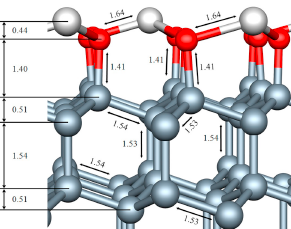 Electron-affinity and surface-stability of aluminium-oxide terminated diamond surfaces
Electron-affinity and surface-stability of aluminium-oxide terminated diamond surfaces
Control over the chemical termination of diamond surfaces has shown great promise in the realization of field-emission applications, the selection of charge states of near-surface color-centers such as NV, and the realization of surface-conductive channels for electronic device applications. Efficient electron-emission exploiting the negative electron-affinity requires a stable surface treatment that can operate over a useful range of temperatures, for which H-termination fails. For compounds involving oxygen, surface geometry and layer stoichiometry are thought to be critical parameters in engineering the desired affinity. In this study, we show that large negative electron-affinities (−2 to −3 eV) are found for surfaces with an AlO3 stoichiometry, and the formation is exothermic. Higher proportions of Al increases the likelihood of metallic bonding between Al atoms, decreasing the bond-polarity and increasing the electron affinity (making it less negative). AlO2 and Al2O3 present unfavorable electron affinities, and have a lower thermal stability.
Go back